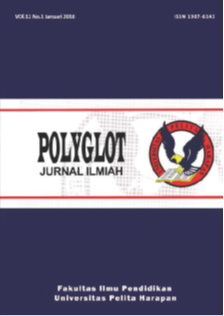A Comparison of STAD and Drill Strategy in Increasing Grade V Students’ Cognitive Achievement on Ratios
DOI:
https://doi.org/10.19166/pji.v12i1.378Keywords:
STAD, Student Team Achievement Division, drill strategy, cognitive achievement, ratios, strategi, pencapaian kognitif, perbandinganAbstract
This research is aimed at determining whether grade V students’ cognitive achievement increase using STAD and drill strategy. This research is also aimed at comparing STAD and drill strategy in increasing the cognitive achievement of grade V students on the topic of ratios in mathematics. The design of this research is a pretest-posttest two-group design. The sampling is done randomly. Descriptive statistics and non-parametric statistics are used to analyze the data. Using SPSS, the results showed that the grade V students’ cognitive achievement on ratios increased after studying mathematics using STAD and drill strategy. However, there was no significant difference in results between STAD and drill strategy in increasing the student’s cognitive achievement. Therefore, the grade V students’ cognitive achievement in both classes increased at a similar level using STAD and drill strategy.
BAHASA INDONESIA ABSTRAK: Penelitian ini bertujuan untuk mengetahui apakah pencapaian kognitif siswa kelas V dapat meningkat menggunakan STAD dan drill strategy. Penelitian ini juga bertujuan untuk membandingkan STAD dan drill strategy dalam meningkatkan pencapaian kognitif siswa kelas V pada topik perbandingan dalam pembelajaran matematika. Desain dari penelitian ini adalah pretest-posttest two group design. Pengambilan sample dilakukan secara random. Statistik deskriptif dan statistik non-parametrik adalah teknik yang digunakan untuk menganalisis data pada penelitian ini. Dengan menggunakan SPSS, penelitian ini menunjukkan bahwa pencapaian kognitif siswa kelas V pada topik perbandingan meningkat setelah pembelajaran matematika menggunakan STAD dan drill strategy. Namun, tidak ada perbedaan antara STAD dan drill strategy dalam meningkatkan pencapaian kognitif siswa kelas V pada topik perbandingan. Maka dari itu, pencapaian kognitif siswa kelas V pada kedua kelas meningkat pada tingkatan yang hampir setara dengan menggunakan STAD dan drill strategy.
References
Anderson, L. W., & Krathwohl, D. R. (2001). A taxonomy for learning, teaching, and assessing. New York: Addison Wesley Longman.
Barry, K., & King, L. (2006). Beginning teaching and beyond (3rd ed.). Sydney: 2006.
Djamarah, S. B., & Zain, A. (2006). Strategi belajar-mengajar. Jakarta: Rineka Cipta.
Eggen, P., & Kauchak, D. (2007). Educational psychology: Windows on classrooms (7th ed.). Upper Saddle River, NJ: Pearson Prentice Hall.
Fahyudin, Liliasari, Sabandar, J., & Martoprawiro, M. A. (2015, February). Perbandingan metode kolaborasi dengan contoh tugas dan belajar individual dalam pengembangan kemampuan pemecahan masalah kimia. Cakrawala Pendidikan, 34(1), 34-46. http://dx.doi.org/10.21831/cp.v1i1.4174
Galyean, B. (1979). A confluent approach to curriculum design. Foreign Language Annals, 12(2), 121-127. http://dx.doi.org/10.1111/j.1944-9720.1979.tb00155.x
Ismail et al. (2008). Pembaharuan dalam pembelajaran matematika. Jakarta: Universitas Terbuka.
Kagan, S., & Kagan, M. (2009). Kagan cooperative learning. San Clemente, CA: Kagan Publishing.
Rusman. (2012). Seri manajemen sekolah nermutu: Model-Model pembelajaran (2nd ed.). Jakarta: Rajawali Pers.
Sanjaya, W. (2006). Strategi pembelajaran berorientasi standar proses pendidikan. Jakarta: Prenada Media Group.
Savage, T. V., Savage, M. K., & Armstrong, D. G. (2006). Teaching in the secondary school (6th ed.). Upper Saddle River, NJ: Pearson Merrill Prentice Hall.
Slavin, R. E. (2005). Cooperative learning: Teori, riset dan praktik. Bandung: Nusa Media.
Slavin, R. E. (2006). Educational psychology: Theory and practice (8th ed.). Boston: Pearson Education, Inc.
Sugiyono. (2008). Metode penelitian pendidikan: Pendekatan kuantitatif, kualitatif dan R&D. Bandung: Alfabeta.
Downloads
Published
Issue
Section
License
Authors who publish with this journal agree to the following terms:
1) Authors retain copyright and grant the journal right of first publication with the work simultaneously licensed under a Creative Commons Attribution License (CC-BY-SA 4.0) that allows others to share the work with an acknowledgement of the work's authorship and initial publication in this journal.
2) Authors are able to enter into separate, additional contractual arrangements for the non-exclusive distribution of the journal's published version of the work (e.g., post it to an institutional repository or publish it in a book), with an acknowledgement of its initial publication in this journal.
3) Authors are permitted and encouraged to post their work online (e.g., in institutional repositories or on their website). The final published PDF should be used and bibliographic details that credit the publication in this journal should be included.





